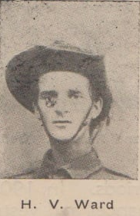
WARD, Herbert William
| Service Number: | 532 |
|---|---|
| Enlisted: | Not yet discovered |
| Last Rank: | Gunner |
| Last Unit: | 31st Infantry Battalion |
| Born: | Not yet discovered |
| Home Town: | Numurkah, Moira, Victoria |
| Schooling: | Not yet discovered |
| Occupation: | Not yet discovered |
| Died: | Died of wounds, France, 27 August 1916, age not yet discovered |
| Cemetery: |
Estaires Communal Cemetery and Extension, France |
| Memorials: | Australian War Memorial Roll of Honour, Boonah War Memorial, Crows Nest (Qld) War Memorial |
World War 1 Service
| 9 Nov 1915: | Involvement Private, 532, 31st Infantry Battalion, Battle for Pozières , --- :embarkation_roll: roll_number: '16' embarkation_place: Melbourne embarkation_ship: HMAT Wandilla embarkation_ship_number: A62 public_note: '' | |
|---|---|---|
| 9 Nov 1915: | Embarked Private, 532, 31st Infantry Battalion, HMAT Wandilla, Melbourne | |
| 27 Aug 1916: | Involvement Gunner, 532, Battle for Pozières , --- :awm_ww1_roll_of_honour_import: awm_service_number: 532 awm_unit: 5th Australian Division Trench Mortars awm_rank: Gunner awm_died_date: 1916-08-27 |
Narrative
Herbert William Ward #532 31st Battalion / 5th Medium Trench Mortar Battery
The Boonah memorial lists a H.V. Ward. Searches of relevant data bases reveal no such soldier but Hebert William Ward seems the best fit.
Herb Ward was a 25 year old printer when he enlisted in Brisbane on 8th July 1915. He reported he had been born in Ipswich to Edith and Richard Ward. Herb’s father when completing the Roll of Honour Circular after his death stated Herb had attended Armidale Public School in NSW. He also replied that the district Herb was mainly associated with was Numurkah, a small town in the Goulburn Valley of Victoria. His enlistment papers show his address as Crow’s Nest Queensland. It is evident that Herb moved around quite a lot and perhaps he spent some time in Boonah as a printer on the local newspaper.
Herb was allocated as an original member of “B” Company, 31st Battalion AIF; which was destined to be part of the 8th Brigade of the 5th Division AIF. The 31st was comprised of companies from both Queensland and Victoria and in early October the Queensland contingent joined the Victorians at Broadmeadows Camp outside Melbourne. The complete battalion embarked on the “Wandilla” at Port Melbourne on 9th November 1915 and disembarked in Suez on 7th December.
By the time that Herb arrived in Egypt, decisions had already been made to evacuate the Australians on Gallipoli and use them as a core of an expanded AIF, boosted by enlistments such as Herb. Both the Gallipoli veterans and the new reinforcements were housed in a large camp at Tel-El-Kabir. Herb would spend quite some time in hospital both there and at Abassia with a number of illnesses.
From March of 1916, elements of the four divisions that would eventually be deployed on the western front began to cross the Mediterranean to Marseilles. The 31st Battalion was one of the last infantry battalions to leave Egypt as it had been guarding the Suez Canal in case of a Turkish assault on this vital communication asset. The 31st when it arrived in Marseilles on 22nd June took a train to Marbecque where the men enjoyed comfortable billets; and were put through gas training and demonstrations of trench mortars and bomb throwing.
On 7th July, the 31st received standby orders to move up to the front in the vicinity of Fromelles. On the same day, Herb’s records indicate that he was transferred to the 5th Medium Trench Mortar Battery. The 31st Battalion meanwhile would go into an ill-conceived attack against the German positions at Fromelles and would suffer almost 50% casualties of killed, wounded or missing; effectively ending the battalion’s capability as a fighting force for the next year.
The trench mortar battery to which Herb had been assigned was still coming to terms with the cumbersome mortars. Nicknamed the “toffee apple” or “plum pudding” the mortar round was a cast iron sphere about the size of a football attached to a 2” pipe. During August of 1916, the 5th MTM Battery were engaged in short barrages of the enemy lines from pre-prepared firing positions. It is recorded in the battery war diary that on 20th August, several mortar crew were wounded while preparing new firing positions. One of those wounded was Herb Ward.
Herb was taken to a casualty clearing station where he succumbed to his wounds on 28th August 1916, aged 26. Herb was buried in the Estaires Communal Cemetery near Lille in Northern France. His headstone lists his parents and gives his birthplace as Ipswich.
Submitted 29 August 2021 by Ian Lang









